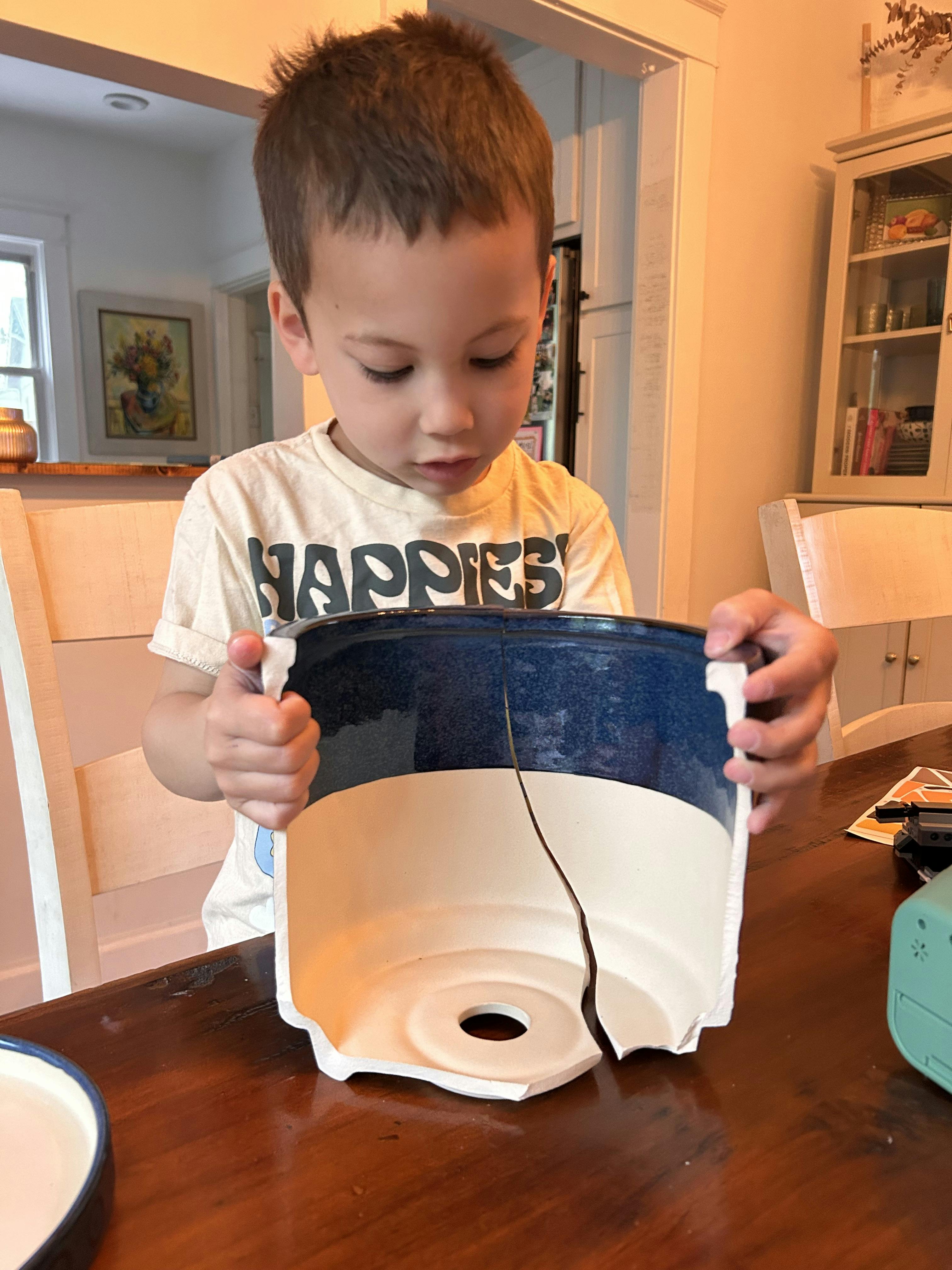Some things are more beautiful because they’ve been broken.
Now, while that may not be true for your new sunglasses, electric razor, or left taillight, I believe it can be for your favorite living room vase—and your former (and present) hurt. That simple truth has changed the way I see my past, how I parent my kids, and even how I follow Jesus.
Stick with me for a few minutes, and I’ll show you how an ancient Japanese art form became one of the most sacred, surprising, and healing parts of my walk with God.
Kintsugi—A Way to Reconnect (Literally)
I’m an Asian-American follower of Jesus, a husband, a dad to two curious and energetic boys, and—maybe most surprisingly—a newly amateur practitioner of the delicate Japanese practice of Kintsugi (keen-TSOO-gee).
If you’re unfamiliar, Kintsugi means “golden repair.” It’s an ancient art form (dating back to at least the 15th Century) where broken pottery is repaired with lacquer and powdered gold. It’s a practical way not to have to splurge on a new dinner plate you shattered, but it’s more than just fixing something. It’s about making it new through its brokenness, not despite it.
The scars aren’t hidden. They’re highlighted. The artist follows the path of brokenness; they don’t try to conceal it. And in the process, the cracks become the most beautiful part.
Just to be clear: I’m not calling myself a Kintsugi artist. Definitely not a master. Think of it as my weird new little Asian hobby. Over the past year, I’ve come nowhere near the 10,000 hours mark. But it’s reconnected me with the part of myself that needed healing, and with a God who doesn’t shy away from brokenness. Here are three things that this ancient Japanese art form taught me about myself, God, and his unending pursuit of healing us.
1. LOVE: Beautiful Because It Was Broken
One of the most stunning aspects of Kintsugi is that repair begins from the inside. It’s the opposite of the “start with the edges” strategy we use when we’re doing a puzzle out of a box. In Kintsugi, the restoration doesn’t start by gluing the outer edge. It begins at the deepest fracture, usually where the break originated.
Now consider what Jesus said to the Pharisees (the teachers of the religious law who were often pretty prideful and self-righteous):
“You clean the outside of the cup and dish, but inside they are full of greed and self-indulgence…” (Matthew 23:25)
Huh. Fascinating, right? God is not fooled by the outside. He looks within. He starts His restoration work where we are truly broken—in our souls. Our insecurities. Our doubts. Our fears. We can mask the outside, but He sees it all. He wants to know us intimately. Not performatively.
And here’s something that strikes me about Jesus: every single person he interacted with was broken. Some of them knew it. Many didn’t. But no one fooled Him. Not once. He knew exactly where their fracture lines ran. And yet, He stayed. He listened. He loved. He healed. Jesus, who took the form of a servant, didn’t come to scold our brokenness, but to dwell in it with us.
Think about it. When something falls and breaks, what does a servant do? A servant doesn’t lecture the pieces. And a good servant won’t sweep it under a rug and pretend it isn’t there. No, he kneels down, and gently gathers them; and if that servant turns out to be an artist of repair (and God is, as the Creator of the Universe and a carpenter in his fleshly form), he then begins the long, loving work of repair.
Kintsugi isn’t about restoring a piece of pottery because it’s still useful. It’s about restoring the object because it has inherent worth.
In modernized Western cultures, we create objects for their usefulness, and when they break, we consider their life cycle to be over. We throw them away when they break. But in the East, the moment something breaks is often a chance for it to “level up.” To go from merely being useful to becoming beautiful.
That’s love.
2. FORGIVENESS: What If the Cracks Are Your Fault?
Unless we’re talking screen protectors from Temu, most cracks don’t just happen.
That’s the hard part. Brokenness often comes from choices, sometimes our choices. We betray. We lash out. We hide. We forget who we are. And those choices fracture our relationships with God, with others, and even with creation itself.
We fail to love God. The result? Distance, cynicism, depression.
We fail to care for creation. The result? Scarcity, imbalance, degradation.
We fail to love others. The result? Conflict, exclusion, racism, poverty, war.
But here’s what scandalizes me: Jesus sees all of these failures in our lives, and still chooses to restore.
He just asks us not to hide.
Adam and Eve hid after their first mistake. It’s human nature. We still do it. Some of us do it in clever, curated, Instagrammable ways. Most of us (like me) are clumsier about it, hiding our mistakes in isolation, busyness, escape, and apathy.
No matter our technique, the truth remains: Hiding delays healing.
On the flip side is confession. That’s an old churchy word, but the late great teacher and writer, Dallas Willard, has given my favorite definition: confession is agreeing with God about what’s true.
So confession is not humiliation. It’s an invitation. It leads to forgiveness.
“The sacrifice you desire is a broken spirit…” (Psalm 51:17)
Kintsugi often makes a vessel stronger than it was before. So does forgiveness.
Case in point: Remember the Apostle Paul?
Paul was a Pharisee. For our purposes, I’m defining a Pharisee as someone who hides their flaws by obeying all the rules or distracts from their flaws by controlling others. That’s who Paul was.
But he had an encounter with Jesus—Love and Truth Incarnate—and would be forever changed. He would go into all kinds of other countries and cultures, spreading a message of the reconciliation of ALL people, ALL nations, to one another under the banner of Jesus. And he became the kind of person who would say this about his own brokenness:
“I will boast all the more gladly about my weaknesses, so that Christ’s power may rest on me… For when I am weak, then I am strong.” (2 Corinthians 12:9-10)
Forgiveness doesn’t ignore your scars. It fills them with the very presence of Jesus, who shines like gold handiwork along a crack.
3. HEALING: Slow, Patient, Worth It
One thing I’ve learned while doing amateur Kintsugi is that it takes time. And I mean a long time.
Every fracture is different. Every curve, every shard, every angle of damage—utterly unique. Some breaks are easy. Some are so delicate, they have to be braced just so and demand hours, even days of waiting between layers, so they cure properly. No two pieces come back together the same way. Sound familiar?
Friend, you are not like anyone else. Your pain, your loss, your path to healing—it’s all one-of-a-kind. And God sees it. He saw it when it happened. He knows the pattern. He isn’t overwhelmed or confused by your story. And He’s not in a rush.
In my marriage, we’ve weathered infertility and miscarriage. I’ve had seasons of deep isolation and spiritual dry spells where I wondered if God even cared. I’ve been frustrated beyond words. But I’ve also been held by Jesus through it. And I’m starting to understand:
Healing is holy ground.
You are in the hands of the Great Physician. The Master Craftsman. The Wonderful Counselor. And you, friend, are worth every extra moment of care.
Your story isn’t over.
A Global Gospel
More and more, I’m trying to learn from Christian artists and theologians from non-Western backgrounds. I’m amazed at how much beauty, truth, and revelation are waiting to be found outside traditional Western frameworks.
One of the voices I admire most is Japanese-American artist Makoto Fujimura. In an episode of the podcast No Small Endeavor (a great follow, by the way), Fujimura says:
“When I began to understand Christianity, I was really astonished that Jesus, in His post-resurrection appearances, could have come back as anything. He’s God, after all. But He chose the human body, and after all he went through, he also came back as a wounded human being! His nail marks are still with him. So Kintsugi became a theological reality for me as well. And isn’t it amazing that Japan, which is, perhaps, ‘alien’ to Christian faith, held on to this idea that brokenness is sacred. Where did that come from?”
Where did that come from? I believe it came from the Spirit of God. Ecclesiastes 3:11 says:
“He has planted eternity in the human heart…”
That means humans everywhere—in ancient Japan, in suburban Kentucky, in rural India, in urban Kenya—have had glimpses of God’s eternal nature written into their hearts. It’s there, all over the place, waiting to be found, in the actual world we live in.
Even the place where Kintsugi was born—Japan—would become a site of violent persecution against Christians just two centuries later. The tension is real. (Watch Silence or read the novel by Shūsaku Endō if you want to go deeper.) But the truth remains: God is not limited by geography, language, or religion.
Suppose eternal truths are planted across time and cultures. In that case, it shouldn’t surprise us too much when we stumble upon a practice that may seem “alien” to Christianity, but actually reflects the very heartbeat of Christ.
Modern-day Christians, swimming in the water of technology, democracy, and wealth, would do well to take a humble posture toward Christians of other times and cultures. It’s a more Christ-like posture than assuming Christianity always has to look, sound, and feel like the one expressed in the church we picked. There’s always more to God than we find expressed in any single culture, and in the global community, there are always great pearls to discover if we’re willing to dive deep enough.
The Master Craftsman
Let me be clear: my little hobby isn’t real Kintsugi. I’m breaking mass-produced mugs. I’m using epoxy and hardware-store glitter, not urushi lacquer. But even the greatest Kintsugi master is just a shadow of the true Artist.
God is actively, patiently restoring all things—not just you and me, but the world itself. That’s what Scripture points to. From Genesis to Revelation: redemption, reconciliation, restoration. I see it everywhere now. In nature. In people. In stories. In Jesus. It’s what gives me hope in the midst of a profoundly broken world.
Want to Try?
What started as a way to reconnect with Asian heritage (full disclosure, I’m half-Filipino, not Japanese) quickly became something more. It gave me a new way to engage with my kids. Turns out, taking old dishes from Goodwill, smashing them on the front porch, and gluing them back together with shimmering gold is a decent afternoon for a kid. Who knew?

But whether you’re doing this as a family or a solo project, here are a few ideas to start practicing the art of repair:
1. Use your hands. Try a hobby. Mend a sock. Build something. Paint-by-sticker. Learn to fix your toaster. It doesn’t matter if the result is ugly. You’ll learn about the Creator in the process.
2. Tell your story. Let people see your cracks. Not to get pity. But so they can see the gold of Christ in you.
3. Ask God to heal you. It’s as simple as a prayer:
“God, I’m cracked in more places than I can count. I’ve tried to hide them, but I want to be made whole. Would you begin the work of putting me back together?”
He will. He always does.
Your scars are sacred. Let Him turn them into gold.










